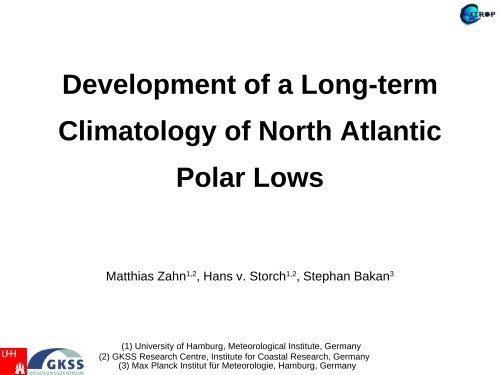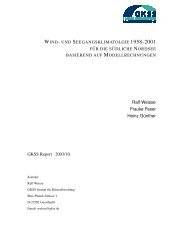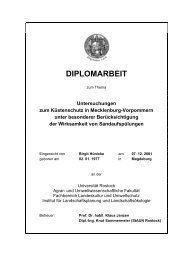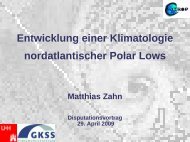A long-term climatology of North Atlantic Polar Lows - Institute of ...
A long-term climatology of North Atlantic Polar Lows - Institute of ...
A long-term climatology of North Atlantic Polar Lows - Institute of ...
Create successful ePaper yourself
Turn your PDF publications into a flip-book with our unique Google optimized e-Paper software.
Development <strong>of</strong> a Long-<strong>term</strong><br />
Climatology <strong>of</strong> <strong>North</strong> <strong>Atlantic</strong><br />
<strong>Polar</strong> <strong>Lows</strong><br />
Matthias Zahn 1,2 , Hans v. Storch 1,2 , Stephan Bakan 3<br />
(1) University <strong>of</strong> Hamburg, Meteorological <strong>Institute</strong>, Germany<br />
(2) GKSS Research Centre, <strong>Institute</strong> for Coastal Research, Germany<br />
(3) Max Planck Institut für Meteorologie, Hamburg, Germany
<strong>Polar</strong> <strong>Lows</strong><br />
● Particular kind <strong>of</strong> low pressure<br />
system<br />
● mesoscale sized (typically<br />
several hundred km in diameter)<br />
● Intense/ strong winds (>15m/s),<br />
● severe weather<br />
● occurring poleward the <strong>Polar</strong><br />
Front in both hemispheres<br />
● Typically induced by<br />
disturbances in the air flow<br />
● Typically driven by convective<br />
processes<br />
Spitzbergen<br />
~300 km<br />
© Dundee Satellite Receiving Station<br />
2<br />
Scandinavia
Further examples <strong>of</strong> <strong>Polar</strong> <strong>Lows</strong><br />
20.12.2002, 2:00<br />
04.03.2008, 11:35 11.03.08, 15:25<br />
Further reading:<br />
Rasmussen and Turner, 2003:<br />
<strong>Polar</strong> <strong>Lows</strong>: Mesoscale Weather Systems<br />
in the <strong>Polar</strong> Regions<br />
16.1.1995, 9:00<br />
IPY-Thorpex field campaign:http://www.ipy-thorpex.com/ , images from http://www.sat.dundee.ac.uk/<br />
Kolstad, E. W. & T. J. Bracegirdle & I. A. Seierstad: Marine cold-air outbreaks in the <strong>North</strong> <strong>Atlantic</strong>: temporal distribution and associations with<br />
large-scale atmospheric circulation. Climate Dynamics, published online 19 June, 2008. DOI:10.1007/s00382-008-0431-5<br />
3
Long<strong>term</strong> <strong>climatology</strong><br />
• Dataset <strong>of</strong> <strong>Polar</strong> Low cases<br />
• Comprehensive measurements are<br />
required to compile such a dataset<br />
• <strong>long</strong> in time<br />
• high in spatial detail<br />
• Homogeneous<br />
• Problem: Such measurements do<br />
usually no exist<br />
4
Solution<br />
• Use <strong>of</strong> numerical models in<br />
combination with existing<br />
measurements to reconstruct the<br />
past state <strong>of</strong> the atmosphere:<br />
=> dynamical downscaling: NCEP (~200 km)<br />
• <strong>Polar</strong> <strong>Lows</strong> need to be automatically<br />
detectable in such data!<br />
LAM (~50 km)<br />
5
Setup <strong>of</strong> my PhD work<br />
● Part 1: Can LAMs reproduce polar lows ?<br />
● Part 2: How to detect polar lows<br />
automatically in LAM output data<br />
● Part 3: Compilation <strong>of</strong> Climatology<br />
6
Ensemble simulations for three<br />
polar low cases in climate mode<br />
NCEP (~200 km)<br />
CLM (~50 km)<br />
Oct. 1993 (Dec. 1993, Jan. 1998)<br />
Initialised: approx. 2 week prior to PL formation<br />
With spectral Nudging (4x) and without (4x) (v. Storch et<br />
al. 2000)<br />
7
Spitzbergen<br />
Oct. 1993 case<br />
Scandinavia<br />
15.Oct.93, 05:24<br />
© Dundee Satellite Receiving Station<br />
8
Mean Sea level pressure (hPa) and<br />
10m wind speed<br />
15. Oct. 1993,<br />
6:00<br />
NCEP<br />
Dundee<br />
15.10.93, 05:24<br />
DWD<br />
9
Mean Sea level pressure (hPa) and<br />
10m wind speed<br />
15. Oct. 1993,<br />
6:00<br />
NCEP<br />
DWD<br />
Dundee<br />
15.10.93, 05:24<br />
CLM01nn CLM02nn CLM03nn CLM04nn<br />
10
Mean Sea level pressure (hPa) and<br />
10m wind speed<br />
15. Oct. 1993,<br />
6:00<br />
NCEP<br />
DWD<br />
Dundee<br />
15.10.93, 05:24<br />
CLM01nn CLM02nn CLM03nn CLM04nn<br />
CLM01sn CLM02sn CLM03sn CLM04sn<br />
11
Two dimensional bandpass filter<br />
isotropic filters are<br />
able to separate<br />
large, medium and<br />
small spatial scales<br />
in a limited<br />
(regional) gridded<br />
field.<br />
Feser, F., and H. von Storch, 2005: Spatial two-dimensional discrete filters for limited area model evaluation purposes. Mon. Wea Rev. 133,<br />
1774-1786<br />
12
0600 UTC<br />
15 Oct 1993<br />
Band-pass filtered mslp (hPa)<br />
NCEP<br />
DWD<br />
(Response<br />
function: wave<br />
lengths between<br />
appr. 200 and 600<br />
km are retained)<br />
CLM01nn CLM02nn CLM03nn CLM04nn<br />
CLM01sn CLM02sn CLM03sn CLM04sn<br />
13
Dec 1993<br />
case:<br />
Response<br />
function: wave<br />
lengths<br />
between appr.<br />
200 - 600 km<br />
are retained<br />
NERC Dundee Satellite Receiving Station<br />
CLM22-sn, band pass filtered<br />
0000 UTC 9 Dec 1993<br />
weatherchart, DWD, 0000 UTC 9 Dec 1993<br />
CLM22-sn, full field<br />
0000 UTC 9 Dec 1993<br />
14
Jan 1998<br />
case:<br />
Response<br />
function: wave<br />
lengths<br />
between appr.<br />
200 - 600 km<br />
are retained<br />
NERC Dundee Satellite Receiving Station<br />
CLM01-sn, band pass filtered<br />
0000 UTC 18 Jan 1998<br />
Weather chart, 0100 UTC 18 Jan 1998<br />
15<br />
CLM01-sn, full mslp field<br />
0000 UTC 18 Jan 1998
In<strong>term</strong>ediate results<br />
• In principle, <strong>Polar</strong> <strong>Lows</strong> can be reproduced<br />
with CLM run in climate mode<br />
• Though, there may be deviations in location<br />
and amount <strong>of</strong> pressure minima<br />
• Without nudging the large scale, the formation<br />
<strong>of</strong> <strong>Polar</strong> <strong>Lows</strong> is subject to considerable<br />
ensemble variability<br />
• A digital filter could be useful for an automatic<br />
detection<br />
16
Setup <strong>of</strong> the detection algorithm<br />
1 st : detection <strong>of</strong> all locations with a minimum in<br />
the filtered mslp field < -1hPa<br />
17
Setup <strong>of</strong> the detection algorithm<br />
1 st : detection <strong>of</strong> all locations with a minimum in the<br />
filtered mslp field < -1hPa<br />
2 nd : combine detected positions to individual<br />
tracks, distance to next (3h) pos < ~200 km<br />
18
Setup <strong>of</strong> the detection algorithm<br />
1 st : detection <strong>of</strong> all locations with a minimum in the<br />
filtered mslp field < -1hPa<br />
2 nd : combine detected positions to individual tracks,<br />
distance to next (3h) pos < ~200 km<br />
3 rd : checking further constraints a<strong>long</strong> the tracks:<br />
• strength <strong>of</strong> the minimum ( ≤ −2hPa once a<strong>long</strong> the track)<br />
• wind speed ( ≥ 13.9 m/s once a<strong>long</strong> the track)<br />
• air-sea temperature difference ( SST − T 500hPa ≥ 43K)<br />
• north south direction <strong>of</strong> the track<br />
• limits to allowable adjacent grid boxes<br />
OR: strength <strong>of</strong> the minimum in the bandpass filtered<br />
mslp field decreases below −6hPa once<br />
19
Setup <strong>of</strong> <strong>long</strong>-<strong>term</strong> simulation:<br />
CLM 2.4.6<br />
initialised: 1.1.1948<br />
finished : 28.2.2006<br />
driven by NCEP/NCAR reanalysis 1<br />
spectral nudging <strong>of</strong> scales > 700 km<br />
together with the algorithm enables a <strong>long</strong>-<strong>term</strong><br />
<strong>climatology</strong> <strong>of</strong> <strong>Polar</strong> <strong>Lows</strong><br />
20
Tracks <strong>of</strong> three cases<br />
Tracks reproduced<br />
and detected even<br />
after a simulation time<br />
<strong>of</strong> several decades<br />
Oct 1993 Dec 1993<br />
Jan 1998<br />
21
Time series <strong>of</strong> the number <strong>of</strong><br />
polar lows per winter<br />
• Mean number <strong>of</strong><br />
polar lows: 56<br />
• Most active winter<br />
was PLS 1981<br />
• Fewest polar lows<br />
were detected in<br />
PLS 1964<br />
• Strong inter annual<br />
variability,<br />
σ = ± 13<br />
• No <strong>long</strong><strong>term</strong> trend<br />
visible<br />
Number <strong>of</strong> detected polar lows per polar low season. One<br />
polar low season is defined as the period starting 1 Jul<br />
and ending 30 Jun the following year.<br />
22
To varied<br />
ws criteria<br />
Algorithm's sensitivity<br />
C > 0.9<br />
To varied<br />
dtz criteria<br />
23
Climatological comparison<br />
Number <strong>of</strong> detected polar lows per polar low season. Our data (black)<br />
and observations (red) by Wilhelmsen (1985)<br />
24
Climatological comparison<br />
Number <strong>of</strong> detected polar lows per polar low season. Our data (black)<br />
and observed (red) by MetNo, Noer, (pers. comm.)<br />
25
C=0,72<br />
C=0,58<br />
26<br />
Monthly comparison <strong>of</strong> our<br />
data (in black) with<br />
observed data (in red)<br />
u.r.: Norwegian Met.<br />
Service<br />
l.l.: Blechschmidt (2008)
Spatial density distribution<br />
Bracegirdle, T. J. and S. L. Gray, 2006<br />
27
Number <strong>of</strong> <strong>Polar</strong> <strong>Lows</strong> in various<br />
subregions<br />
Subregions, for which the number <strong>of</strong> detected polar lows were counted (R1-R14).<br />
28
Canonical Correlation Analysis<br />
(CCA)<br />
Method to study the correlation bewteen two (or<br />
more) random vectors, e.g. X and Y<br />
we used:<br />
X: number <strong>of</strong> <strong>Polar</strong> <strong>Lows</strong> per PLS and subregion<br />
Y: gridded mean MSLP fields per PLS<br />
29
Links to large scale mean pattern<br />
30
Links to large scale mean pattern<br />
31
Final results<br />
● No <strong>long</strong>-<strong>term</strong> trend detectable<br />
● Strong interannual variability<br />
● No one to one similarity to other studies, but<br />
qualitative similarity<br />
● Large scale link: more southward mean flow<br />
=> more <strong>Polar</strong> <strong>Lows</strong><br />
32
Ideas for future work<br />
● Investigate atmospheric conditions during<br />
<strong>Polar</strong> Low events<br />
● Do the same work for future szenarios<br />
● Statistics on different parameters (e.g.<br />
LHFLs)<br />
● Use the CCA results to assess <strong>Polar</strong> Low<br />
behavior on timescales beyond NCEP/NCAR<br />
(MSLP fields <strong>of</strong> Trenberth)<br />
33
Thank you very much<br />
for your attention<br />
Zahn, M., and H. von Storch (2008), A <strong>long</strong>-<strong>term</strong> <strong>climatology</strong> <strong>of</strong><br />
<strong>North</strong> <strong>Atlantic</strong> polar lows, Geophys. Res. Lett., 35, L22702,<br />
doi:10.1029/2008GL035769<br />
Homepage: http://coast.gkss.de/staff/zahn/<br />
34







